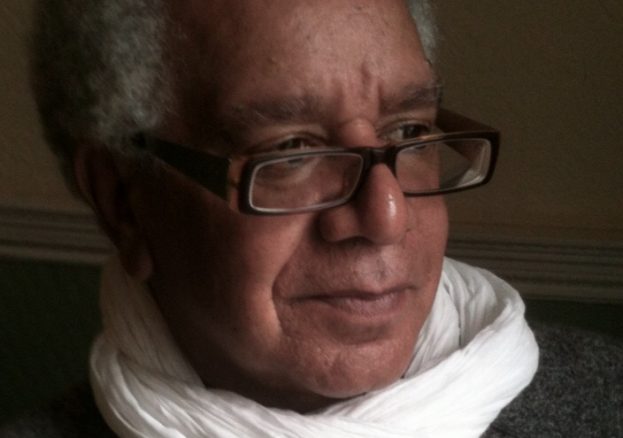
My partner looked at the Georgian print displayed on the wall behind her and pointed out the black lady that appeared in it.
Oh she said “I hadn’t noticed.”
Funny then in real life if we go anywhere, drive, apply for a job, have an opinion, we are very visible.
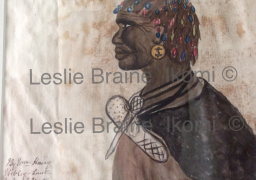
Discovered in a portfolio containing his papers, William Henry Webley painted this picture whilst on the H.M.S Nautilus, the naval escort for the ships taking the black settlers from England to Sierra Leone.
The reverse of this painting has letters from the House of Commons pasted on the back.
In History, Museums and Galleries we are nearly invisible
I got into collecting by accident
I was a scaffolder, hang gliding at the weekends
One weekend in Yorkshire a Hang glider flew into the rocks and I called the ambulance. After he recovered he took me to a pub holding an Antique fair. This was my first experience of antiques and eventually I had my own shop.
My shop sold mainly furniture, occasionally people would bring in pieces of tribal art, I saved these for the French and Americans dealers
One day someone told me they could be valuable so I looked into it
I learnt quickly they were only valuable if they had a European provenance not an African one
I went to Africa a lot and soon discovered how this trade worked.
An engraving arrived in the shop of Cornish Smugglers, surprisingly it had a couple of Africans on the beach with them.
I sold it thinking I would find another one, I never have.
Until then I had never realised that many people of colour had lived in this country before 1948
This history was never taught at my school; we never did the Slave Trade. only Romans
I started to research and educate myself on the history of the African Diaspora through imagery, buying objects and pictures along the way.
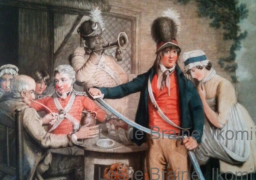
British /African American soldier stands at the back,blowing the trumpet to announce a new recruit. Some African Americans who fought on the British Loyalist side during the American War of Independence 1775-1783 came to Britain after the War
At first I took offence if people offered me pictures of African servants/attendants in Georgian or Victorian dress.
Because I wasn’t aware I would feel angry and think why are they offering me this?
Nowadays, with the internet, you can find names of many people you come across. I take the view that although these people have been attendants they may have married, had children and been buried here.
Not all pictures will make you happy but most will tell a story
To start collecting and finding portrayals of people of colour you have to be thick skinned and tenacious.
Most dealers in the Antique trade only look at the subject of a picture they don’t always see who else is in it.
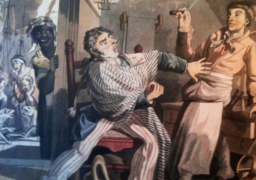
A sailor is shaved on the Dock side. The lady at the door smiles, knowing the sailors behaviour
Dealers who know me are never sure if it will offend and often pull things from under the counter or save a bundle with bits and bobs of ephemera.
Others will say “it’s very scarce and very expensive”
Some will show you racist material looking for a response.
Racist material can be problematic.
Inevitably you will come across it but it has to be looked at for what it is.
It was intended to offend, used as propaganda
I glance at the racist material I come across. Everyone should look at it so they are armed with the knowledge of what has gone before.
If it gets destroyed it will appear again in a different form.
I don’t collect it all, but I keep particular items to use as aTime line.
Knowledge of the past enables you to turn the tables if challenged.
I search everywhere, antique fairs, auctions, car boots, etc
I will look at anything to discover people from the Diaspora, engravings, paintings, mezzotints, photographs, and more
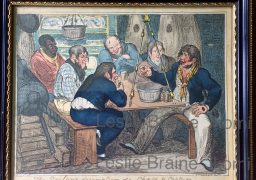
The Sailors Description of a Chase and Capture 1822
On board ship, 6 sailors, one of them black,sit round a plank table drinking grog and listening to a Sailors story of chasing the French in the English Channel when he was on “The Flying Saucy” which was The Temeraire.
The Georgian period is interesting.
Georgian prints were bought or hired by the upper and middle classes, to show to their friends at dinner parties and gatherings. Discussing the news, politics, and gossip, in an age before television and social media.
They were produced to be thrown away but many were placed in libraries and collections.
They come on to the market today 250 years or more after they were produced and who do we find in the background of the prints?
People of colour, selling their wares working as sailors, boxers, soldiers, domestic servants, coachmen, side by side with the population.
I try to collect positive images, though it’s not always possible, but I get taken in surprising directions
We are everywhere, buy what you like and what you can afford.
Look at your own family records and photographs. Save posters, leaflets, photographs from events you attend
Remember you are part of the black history of Britain and one day people will collect pictures and ephemera about you
